BMA247 Organisational Behaviour: Expressing Anger Benefits?
VerifiedAdded on 2023/06/13
|8
|2214
|207
Essay
AI Summary
This essay explores the complex role of expressing anger in the workplace, arguing that while often viewed negatively, it can sometimes be beneficial. The essay discusses how expressing anger can help individuals stand up for themselves, combat bullying, secure deals, and emphasize crucial points in decision-making processes. It acknowledges the potential downsides of unmanaged anger, such as decreased job satisfaction, negative impacts on team coordination, and the risk of emotional contagion. The essay concludes that while anger can be a valuable tool for achieving targets and driving innovation, it must be carefully managed to avoid detrimental effects on employee well-being and organizational harmony. Desklib provides students access to similar essays and solved assignments.
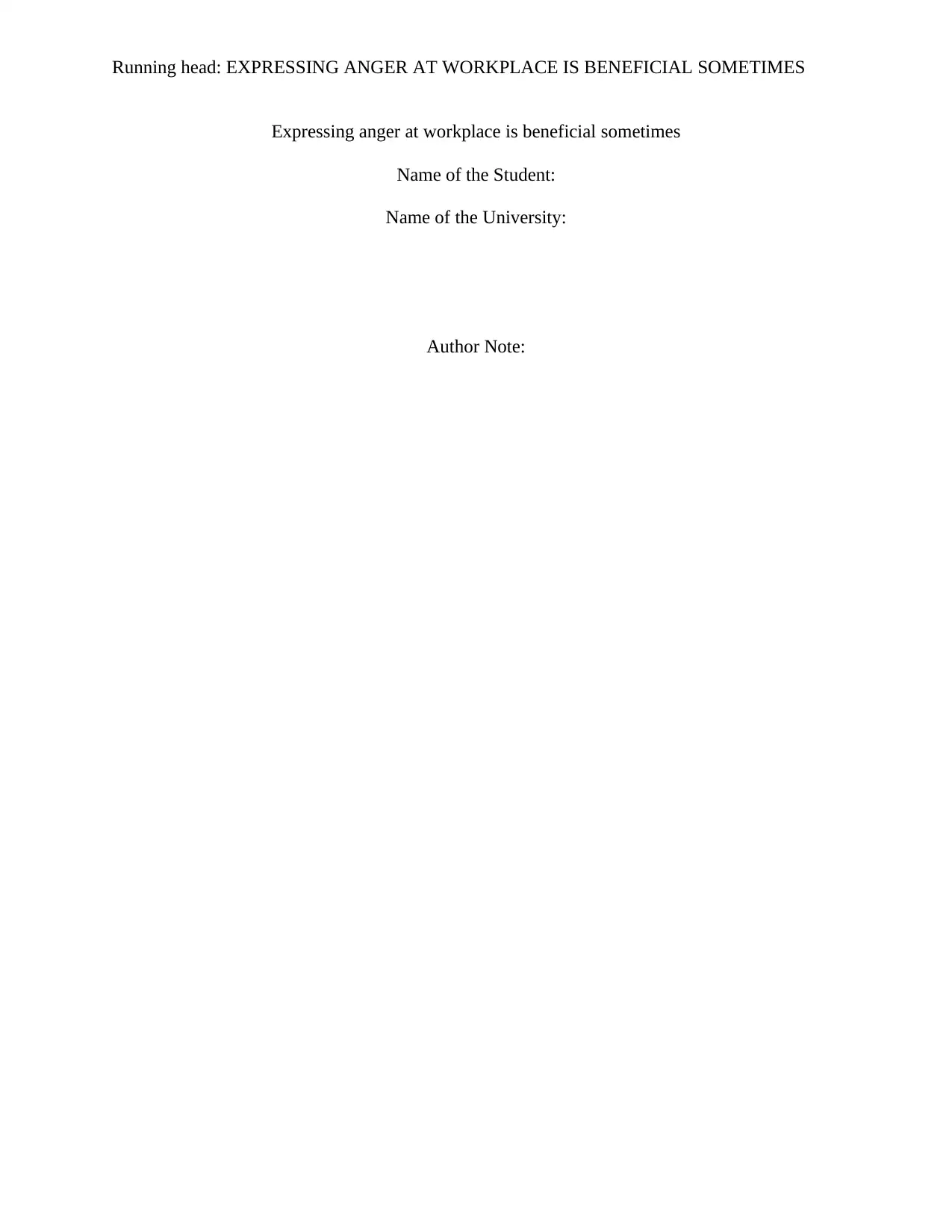
Running head: EXPRESSING ANGER AT WORKPLACE IS BENEFICIAL SOMETIMES
Expressing anger at workplace is beneficial sometimes
Name of the Student:
Name of the University:
Author Note:
Expressing anger at workplace is beneficial sometimes
Name of the Student:
Name of the University:
Author Note:
Paraphrase This Document
Need a fresh take? Get an instant paraphrase of this document with our AI Paraphraser
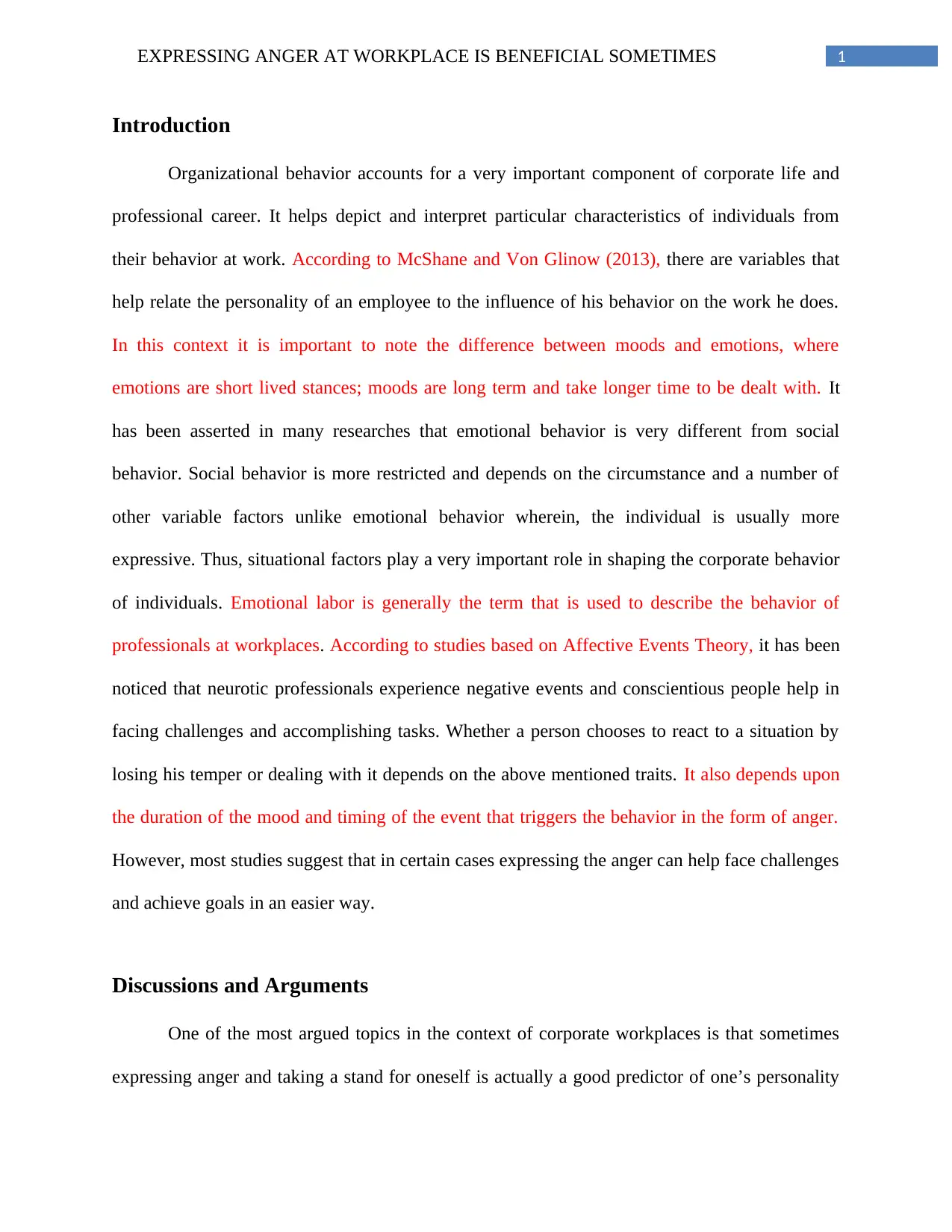
1EXPRESSING ANGER AT WORKPLACE IS BENEFICIAL SOMETIMES
Introduction
Organizational behavior accounts for a very important component of corporate life and
professional career. It helps depict and interpret particular characteristics of individuals from
their behavior at work. According to McShane and Von Glinow (2013), there are variables that
help relate the personality of an employee to the influence of his behavior on the work he does.
In this context it is important to note the difference between moods and emotions, where
emotions are short lived stances; moods are long term and take longer time to be dealt with. It
has been asserted in many researches that emotional behavior is very different from social
behavior. Social behavior is more restricted and depends on the circumstance and a number of
other variable factors unlike emotional behavior wherein, the individual is usually more
expressive. Thus, situational factors play a very important role in shaping the corporate behavior
of individuals. Emotional labor is generally the term that is used to describe the behavior of
professionals at workplaces. According to studies based on Affective Events Theory, it has been
noticed that neurotic professionals experience negative events and conscientious people help in
facing challenges and accomplishing tasks. Whether a person chooses to react to a situation by
losing his temper or dealing with it depends on the above mentioned traits. It also depends upon
the duration of the mood and timing of the event that triggers the behavior in the form of anger.
However, most studies suggest that in certain cases expressing the anger can help face challenges
and achieve goals in an easier way.
Discussions and Arguments
One of the most argued topics in the context of corporate workplaces is that sometimes
expressing anger and taking a stand for oneself is actually a good predictor of one’s personality
Introduction
Organizational behavior accounts for a very important component of corporate life and
professional career. It helps depict and interpret particular characteristics of individuals from
their behavior at work. According to McShane and Von Glinow (2013), there are variables that
help relate the personality of an employee to the influence of his behavior on the work he does.
In this context it is important to note the difference between moods and emotions, where
emotions are short lived stances; moods are long term and take longer time to be dealt with. It
has been asserted in many researches that emotional behavior is very different from social
behavior. Social behavior is more restricted and depends on the circumstance and a number of
other variable factors unlike emotional behavior wherein, the individual is usually more
expressive. Thus, situational factors play a very important role in shaping the corporate behavior
of individuals. Emotional labor is generally the term that is used to describe the behavior of
professionals at workplaces. According to studies based on Affective Events Theory, it has been
noticed that neurotic professionals experience negative events and conscientious people help in
facing challenges and accomplishing tasks. Whether a person chooses to react to a situation by
losing his temper or dealing with it depends on the above mentioned traits. It also depends upon
the duration of the mood and timing of the event that triggers the behavior in the form of anger.
However, most studies suggest that in certain cases expressing the anger can help face challenges
and achieve goals in an easier way.
Discussions and Arguments
One of the most argued topics in the context of corporate workplaces is that sometimes
expressing anger and taking a stand for oneself is actually a good predictor of one’s personality
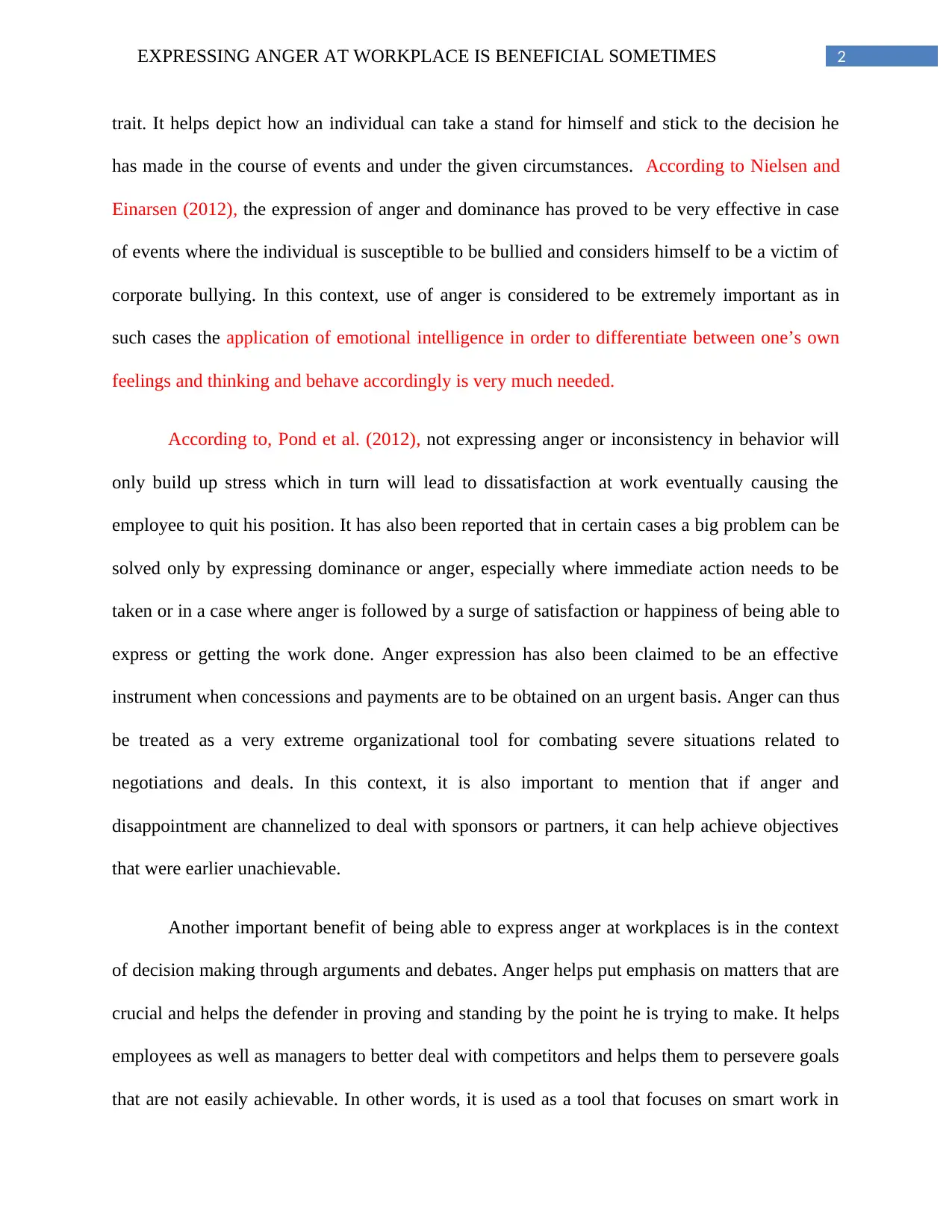
2EXPRESSING ANGER AT WORKPLACE IS BENEFICIAL SOMETIMES
trait. It helps depict how an individual can take a stand for himself and stick to the decision he
has made in the course of events and under the given circumstances. According to Nielsen and
Einarsen (2012), the expression of anger and dominance has proved to be very effective in case
of events where the individual is susceptible to be bullied and considers himself to be a victim of
corporate bullying. In this context, use of anger is considered to be extremely important as in
such cases the application of emotional intelligence in order to differentiate between one’s own
feelings and thinking and behave accordingly is very much needed.
According to, Pond et al. (2012), not expressing anger or inconsistency in behavior will
only build up stress which in turn will lead to dissatisfaction at work eventually causing the
employee to quit his position. It has also been reported that in certain cases a big problem can be
solved only by expressing dominance or anger, especially where immediate action needs to be
taken or in a case where anger is followed by a surge of satisfaction or happiness of being able to
express or getting the work done. Anger expression has also been claimed to be an effective
instrument when concessions and payments are to be obtained on an urgent basis. Anger can thus
be treated as a very extreme organizational tool for combating severe situations related to
negotiations and deals. In this context, it is also important to mention that if anger and
disappointment are channelized to deal with sponsors or partners, it can help achieve objectives
that were earlier unachievable.
Another important benefit of being able to express anger at workplaces is in the context
of decision making through arguments and debates. Anger helps put emphasis on matters that are
crucial and helps the defender in proving and standing by the point he is trying to make. It helps
employees as well as managers to better deal with competitors and helps them to persevere goals
that are not easily achievable. In other words, it is used as a tool that focuses on smart work in
trait. It helps depict how an individual can take a stand for himself and stick to the decision he
has made in the course of events and under the given circumstances. According to Nielsen and
Einarsen (2012), the expression of anger and dominance has proved to be very effective in case
of events where the individual is susceptible to be bullied and considers himself to be a victim of
corporate bullying. In this context, use of anger is considered to be extremely important as in
such cases the application of emotional intelligence in order to differentiate between one’s own
feelings and thinking and behave accordingly is very much needed.
According to, Pond et al. (2012), not expressing anger or inconsistency in behavior will
only build up stress which in turn will lead to dissatisfaction at work eventually causing the
employee to quit his position. It has also been reported that in certain cases a big problem can be
solved only by expressing dominance or anger, especially where immediate action needs to be
taken or in a case where anger is followed by a surge of satisfaction or happiness of being able to
express or getting the work done. Anger expression has also been claimed to be an effective
instrument when concessions and payments are to be obtained on an urgent basis. Anger can thus
be treated as a very extreme organizational tool for combating severe situations related to
negotiations and deals. In this context, it is also important to mention that if anger and
disappointment are channelized to deal with sponsors or partners, it can help achieve objectives
that were earlier unachievable.
Another important benefit of being able to express anger at workplaces is in the context
of decision making through arguments and debates. Anger helps put emphasis on matters that are
crucial and helps the defender in proving and standing by the point he is trying to make. It helps
employees as well as managers to better deal with competitors and helps them to persevere goals
that are not easily achievable. In other words, it is used as a tool that focuses on smart work in
⊘ This is a preview!⊘
Do you want full access?
Subscribe today to unlock all pages.

Trusted by 1+ million students worldwide
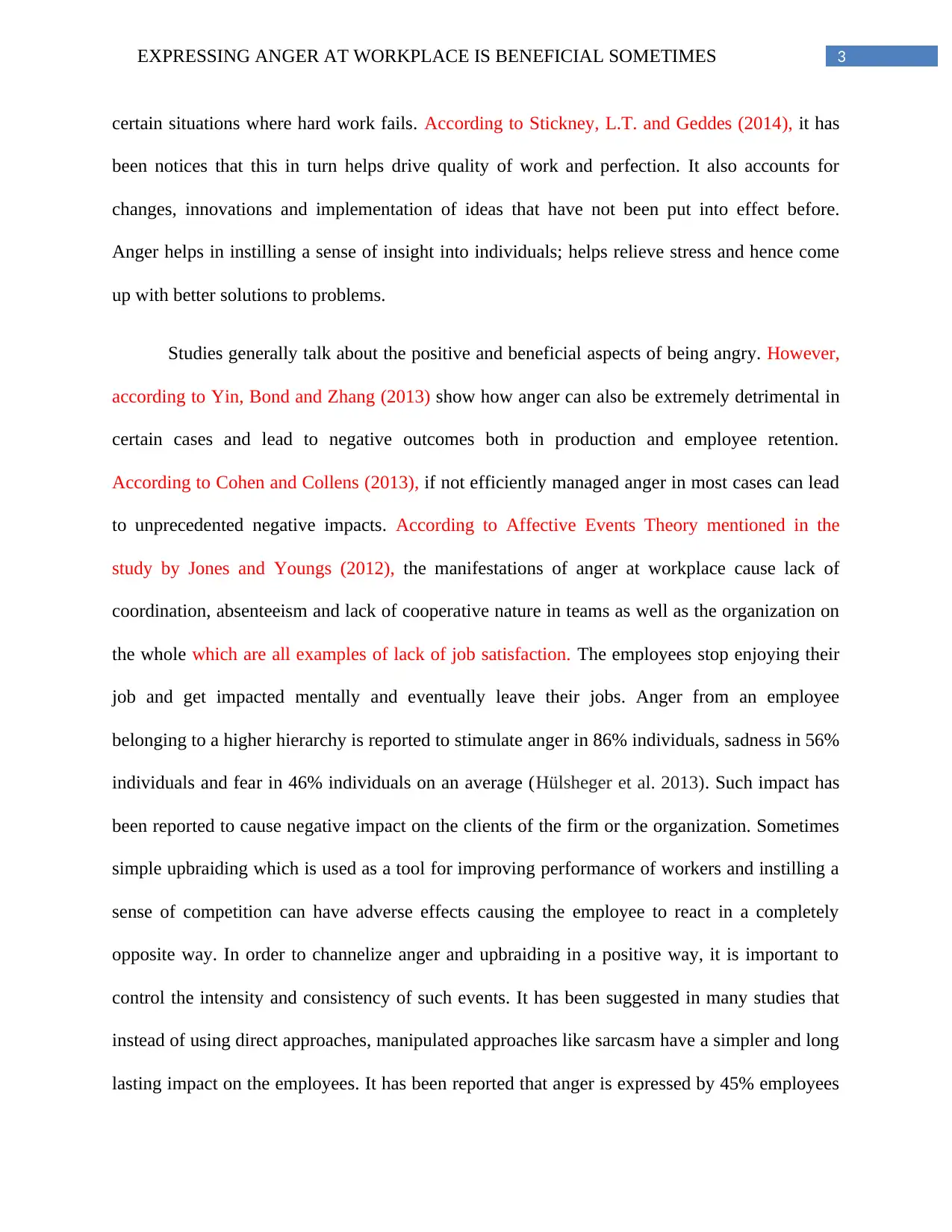
3EXPRESSING ANGER AT WORKPLACE IS BENEFICIAL SOMETIMES
certain situations where hard work fails. According to Stickney, L.T. and Geddes (2014), it has
been notices that this in turn helps drive quality of work and perfection. It also accounts for
changes, innovations and implementation of ideas that have not been put into effect before.
Anger helps in instilling a sense of insight into individuals; helps relieve stress and hence come
up with better solutions to problems.
Studies generally talk about the positive and beneficial aspects of being angry. However,
according to Yin, Bond and Zhang (2013) show how anger can also be extremely detrimental in
certain cases and lead to negative outcomes both in production and employee retention.
According to Cohen and Collens (2013), if not efficiently managed anger in most cases can lead
to unprecedented negative impacts. According to Affective Events Theory mentioned in the
study by Jones and Youngs (2012), the manifestations of anger at workplace cause lack of
coordination, absenteeism and lack of cooperative nature in teams as well as the organization on
the whole which are all examples of lack of job satisfaction. The employees stop enjoying their
job and get impacted mentally and eventually leave their jobs. Anger from an employee
belonging to a higher hierarchy is reported to stimulate anger in 86% individuals, sadness in 56%
individuals and fear in 46% individuals on an average (Hülsheger et al. 2013). Such impact has
been reported to cause negative impact on the clients of the firm or the organization. Sometimes
simple upbraiding which is used as a tool for improving performance of workers and instilling a
sense of competition can have adverse effects causing the employee to react in a completely
opposite way. In order to channelize anger and upbraiding in a positive way, it is important to
control the intensity and consistency of such events. It has been suggested in many studies that
instead of using direct approaches, manipulated approaches like sarcasm have a simpler and long
lasting impact on the employees. It has been reported that anger is expressed by 45% employees
certain situations where hard work fails. According to Stickney, L.T. and Geddes (2014), it has
been notices that this in turn helps drive quality of work and perfection. It also accounts for
changes, innovations and implementation of ideas that have not been put into effect before.
Anger helps in instilling a sense of insight into individuals; helps relieve stress and hence come
up with better solutions to problems.
Studies generally talk about the positive and beneficial aspects of being angry. However,
according to Yin, Bond and Zhang (2013) show how anger can also be extremely detrimental in
certain cases and lead to negative outcomes both in production and employee retention.
According to Cohen and Collens (2013), if not efficiently managed anger in most cases can lead
to unprecedented negative impacts. According to Affective Events Theory mentioned in the
study by Jones and Youngs (2012), the manifestations of anger at workplace cause lack of
coordination, absenteeism and lack of cooperative nature in teams as well as the organization on
the whole which are all examples of lack of job satisfaction. The employees stop enjoying their
job and get impacted mentally and eventually leave their jobs. Anger from an employee
belonging to a higher hierarchy is reported to stimulate anger in 86% individuals, sadness in 56%
individuals and fear in 46% individuals on an average (Hülsheger et al. 2013). Such impact has
been reported to cause negative impact on the clients of the firm or the organization. Sometimes
simple upbraiding which is used as a tool for improving performance of workers and instilling a
sense of competition can have adverse effects causing the employee to react in a completely
opposite way. In order to channelize anger and upbraiding in a positive way, it is important to
control the intensity and consistency of such events. It has been suggested in many studies that
instead of using direct approaches, manipulated approaches like sarcasm have a simpler and long
lasting impact on the employees. It has been reported that anger is expressed by 45% employees
Paraphrase This Document
Need a fresh take? Get an instant paraphrase of this document with our AI Paraphraser
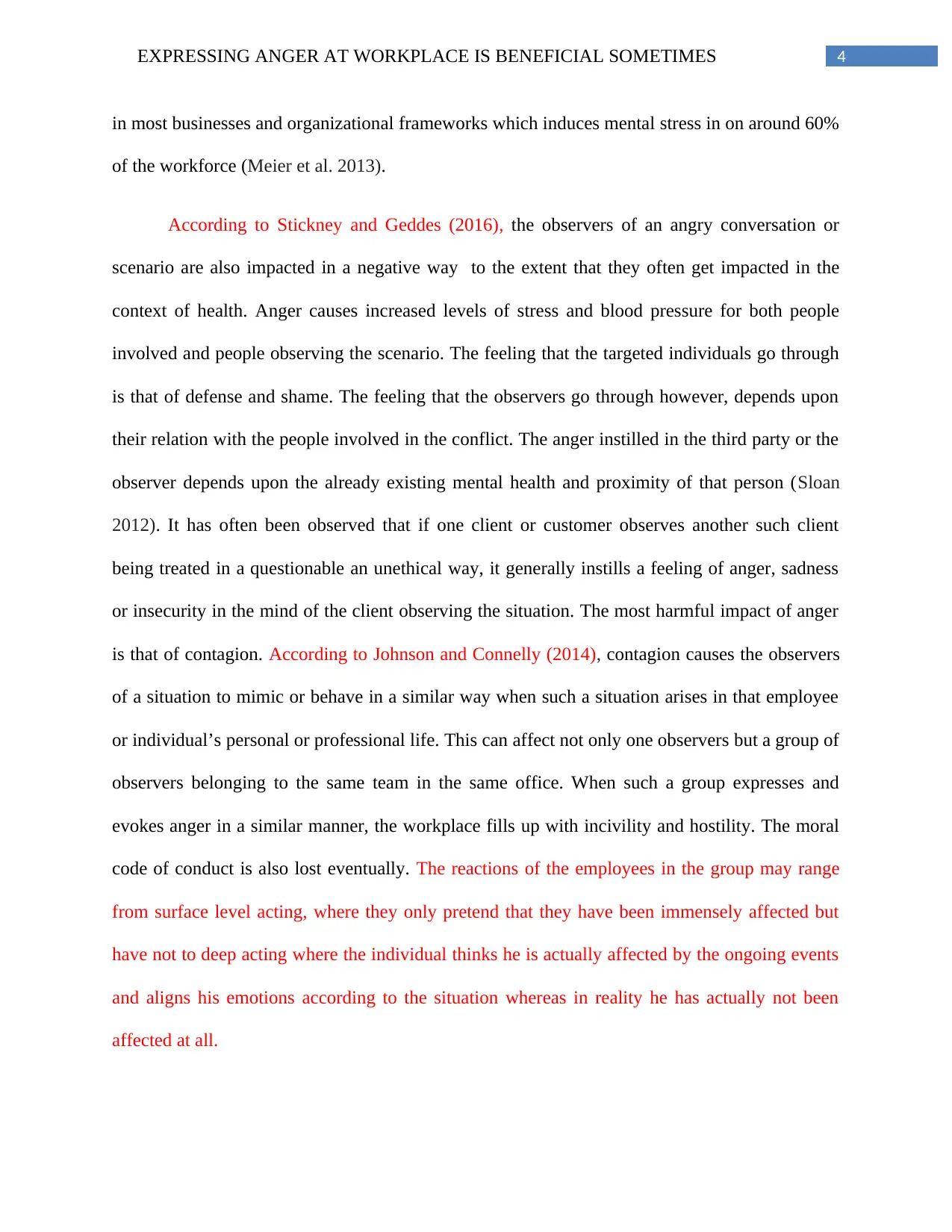
4EXPRESSING ANGER AT WORKPLACE IS BENEFICIAL SOMETIMES
in most businesses and organizational frameworks which induces mental stress in on around 60%
of the workforce (Meier et al. 2013).
According to Stickney and Geddes (2016), the observers of an angry conversation or
scenario are also impacted in a negative way to the extent that they often get impacted in the
context of health. Anger causes increased levels of stress and blood pressure for both people
involved and people observing the scenario. The feeling that the targeted individuals go through
is that of defense and shame. The feeling that the observers go through however, depends upon
their relation with the people involved in the conflict. The anger instilled in the third party or the
observer depends upon the already existing mental health and proximity of that person (Sloan
2012). It has often been observed that if one client or customer observes another such client
being treated in a questionable an unethical way, it generally instills a feeling of anger, sadness
or insecurity in the mind of the client observing the situation. The most harmful impact of anger
is that of contagion. According to Johnson and Connelly (2014), contagion causes the observers
of a situation to mimic or behave in a similar way when such a situation arises in that employee
or individual’s personal or professional life. This can affect not only one observers but a group of
observers belonging to the same team in the same office. When such a group expresses and
evokes anger in a similar manner, the workplace fills up with incivility and hostility. The moral
code of conduct is also lost eventually. The reactions of the employees in the group may range
from surface level acting, where they only pretend that they have been immensely affected but
have not to deep acting where the individual thinks he is actually affected by the ongoing events
and aligns his emotions according to the situation whereas in reality he has actually not been
affected at all.
in most businesses and organizational frameworks which induces mental stress in on around 60%
of the workforce (Meier et al. 2013).
According to Stickney and Geddes (2016), the observers of an angry conversation or
scenario are also impacted in a negative way to the extent that they often get impacted in the
context of health. Anger causes increased levels of stress and blood pressure for both people
involved and people observing the scenario. The feeling that the targeted individuals go through
is that of defense and shame. The feeling that the observers go through however, depends upon
their relation with the people involved in the conflict. The anger instilled in the third party or the
observer depends upon the already existing mental health and proximity of that person (Sloan
2012). It has often been observed that if one client or customer observes another such client
being treated in a questionable an unethical way, it generally instills a feeling of anger, sadness
or insecurity in the mind of the client observing the situation. The most harmful impact of anger
is that of contagion. According to Johnson and Connelly (2014), contagion causes the observers
of a situation to mimic or behave in a similar way when such a situation arises in that employee
or individual’s personal or professional life. This can affect not only one observers but a group of
observers belonging to the same team in the same office. When such a group expresses and
evokes anger in a similar manner, the workplace fills up with incivility and hostility. The moral
code of conduct is also lost eventually. The reactions of the employees in the group may range
from surface level acting, where they only pretend that they have been immensely affected but
have not to deep acting where the individual thinks he is actually affected by the ongoing events
and aligns his emotions according to the situation whereas in reality he has actually not been
affected at all.
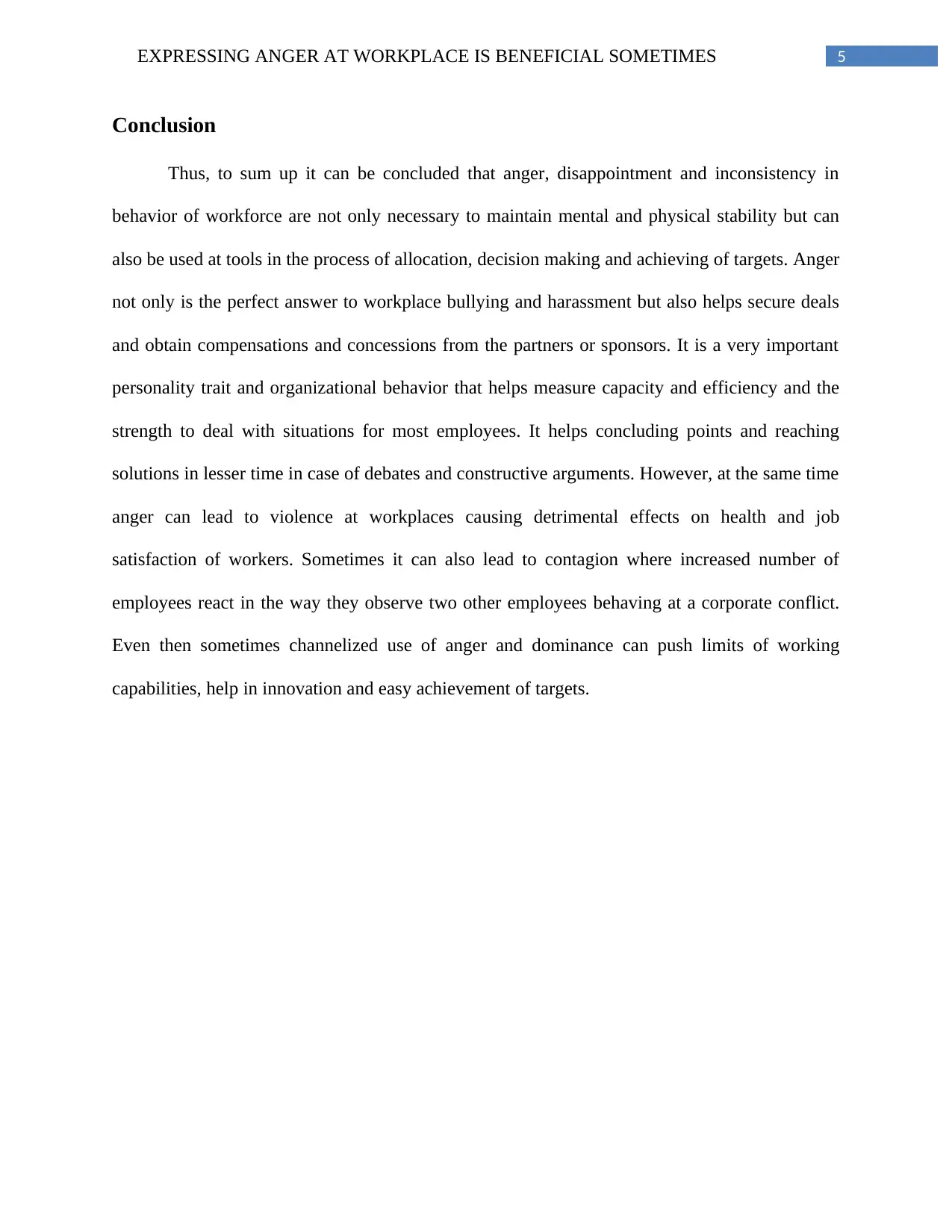
5EXPRESSING ANGER AT WORKPLACE IS BENEFICIAL SOMETIMES
Conclusion
Thus, to sum up it can be concluded that anger, disappointment and inconsistency in
behavior of workforce are not only necessary to maintain mental and physical stability but can
also be used at tools in the process of allocation, decision making and achieving of targets. Anger
not only is the perfect answer to workplace bullying and harassment but also helps secure deals
and obtain compensations and concessions from the partners or sponsors. It is a very important
personality trait and organizational behavior that helps measure capacity and efficiency and the
strength to deal with situations for most employees. It helps concluding points and reaching
solutions in lesser time in case of debates and constructive arguments. However, at the same time
anger can lead to violence at workplaces causing detrimental effects on health and job
satisfaction of workers. Sometimes it can also lead to contagion where increased number of
employees react in the way they observe two other employees behaving at a corporate conflict.
Even then sometimes channelized use of anger and dominance can push limits of working
capabilities, help in innovation and easy achievement of targets.
Conclusion
Thus, to sum up it can be concluded that anger, disappointment and inconsistency in
behavior of workforce are not only necessary to maintain mental and physical stability but can
also be used at tools in the process of allocation, decision making and achieving of targets. Anger
not only is the perfect answer to workplace bullying and harassment but also helps secure deals
and obtain compensations and concessions from the partners or sponsors. It is a very important
personality trait and organizational behavior that helps measure capacity and efficiency and the
strength to deal with situations for most employees. It helps concluding points and reaching
solutions in lesser time in case of debates and constructive arguments. However, at the same time
anger can lead to violence at workplaces causing detrimental effects on health and job
satisfaction of workers. Sometimes it can also lead to contagion where increased number of
employees react in the way they observe two other employees behaving at a corporate conflict.
Even then sometimes channelized use of anger and dominance can push limits of working
capabilities, help in innovation and easy achievement of targets.
⊘ This is a preview!⊘
Do you want full access?
Subscribe today to unlock all pages.

Trusted by 1+ million students worldwide
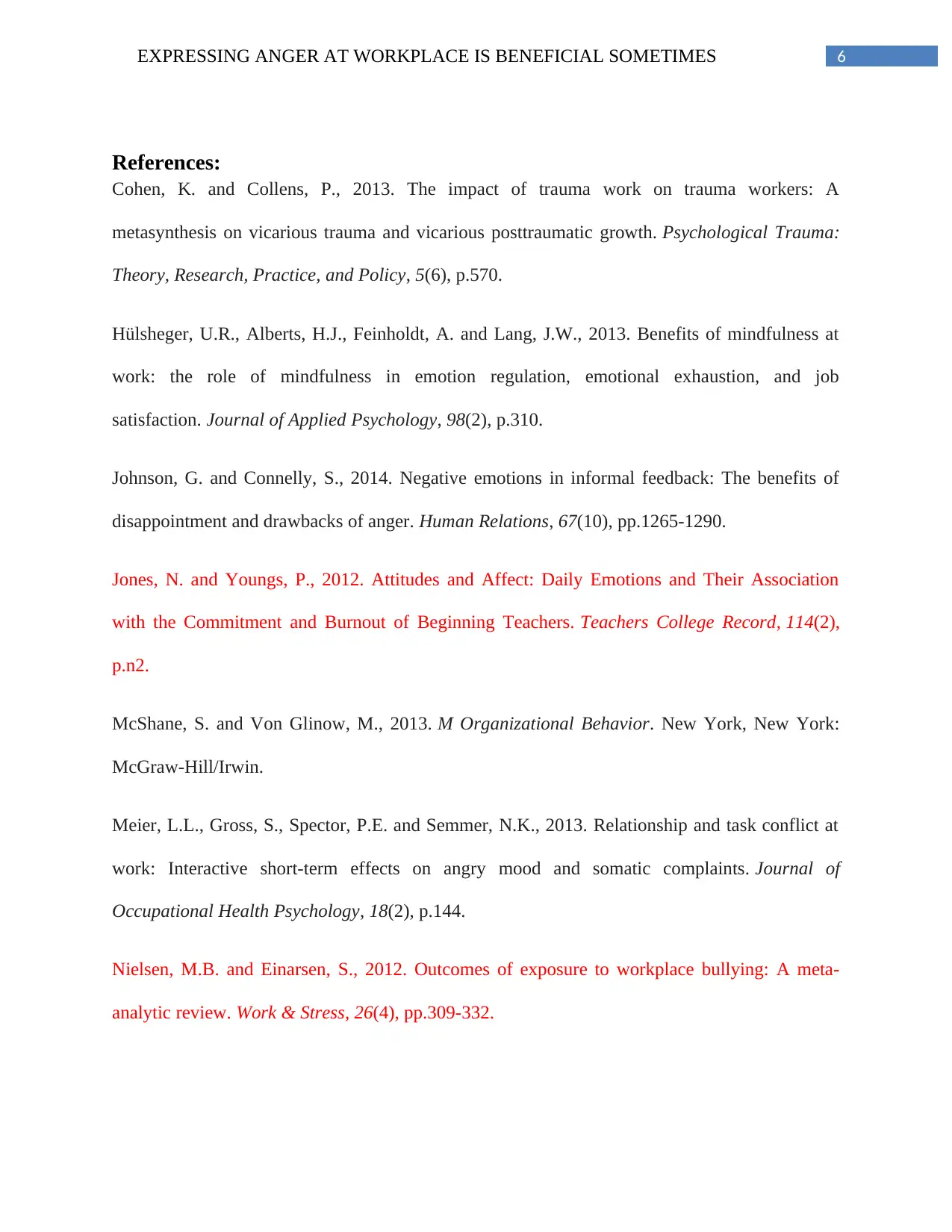
6EXPRESSING ANGER AT WORKPLACE IS BENEFICIAL SOMETIMES
References:
Cohen, K. and Collens, P., 2013. The impact of trauma work on trauma workers: A
metasynthesis on vicarious trauma and vicarious posttraumatic growth. Psychological Trauma:
Theory, Research, Practice, and Policy, 5(6), p.570.
Hülsheger, U.R., Alberts, H.J., Feinholdt, A. and Lang, J.W., 2013. Benefits of mindfulness at
work: the role of mindfulness in emotion regulation, emotional exhaustion, and job
satisfaction. Journal of Applied Psychology, 98(2), p.310.
Johnson, G. and Connelly, S., 2014. Negative emotions in informal feedback: The benefits of
disappointment and drawbacks of anger. Human Relations, 67(10), pp.1265-1290.
Jones, N. and Youngs, P., 2012. Attitudes and Affect: Daily Emotions and Their Association
with the Commitment and Burnout of Beginning Teachers. Teachers College Record, 114(2),
p.n2.
McShane, S. and Von Glinow, M., 2013. M Organizational Behavior. New York, New York:
McGraw-Hill/Irwin.
Meier, L.L., Gross, S., Spector, P.E. and Semmer, N.K., 2013. Relationship and task conflict at
work: Interactive short-term effects on angry mood and somatic complaints. Journal of
Occupational Health Psychology, 18(2), p.144.
Nielsen, M.B. and Einarsen, S., 2012. Outcomes of exposure to workplace bullying: A meta-
analytic review. Work & Stress, 26(4), pp.309-332.
References:
Cohen, K. and Collens, P., 2013. The impact of trauma work on trauma workers: A
metasynthesis on vicarious trauma and vicarious posttraumatic growth. Psychological Trauma:
Theory, Research, Practice, and Policy, 5(6), p.570.
Hülsheger, U.R., Alberts, H.J., Feinholdt, A. and Lang, J.W., 2013. Benefits of mindfulness at
work: the role of mindfulness in emotion regulation, emotional exhaustion, and job
satisfaction. Journal of Applied Psychology, 98(2), p.310.
Johnson, G. and Connelly, S., 2014. Negative emotions in informal feedback: The benefits of
disappointment and drawbacks of anger. Human Relations, 67(10), pp.1265-1290.
Jones, N. and Youngs, P., 2012. Attitudes and Affect: Daily Emotions and Their Association
with the Commitment and Burnout of Beginning Teachers. Teachers College Record, 114(2),
p.n2.
McShane, S. and Von Glinow, M., 2013. M Organizational Behavior. New York, New York:
McGraw-Hill/Irwin.
Meier, L.L., Gross, S., Spector, P.E. and Semmer, N.K., 2013. Relationship and task conflict at
work: Interactive short-term effects on angry mood and somatic complaints. Journal of
Occupational Health Psychology, 18(2), p.144.
Nielsen, M.B. and Einarsen, S., 2012. Outcomes of exposure to workplace bullying: A meta-
analytic review. Work & Stress, 26(4), pp.309-332.
Paraphrase This Document
Need a fresh take? Get an instant paraphrase of this document with our AI Paraphraser
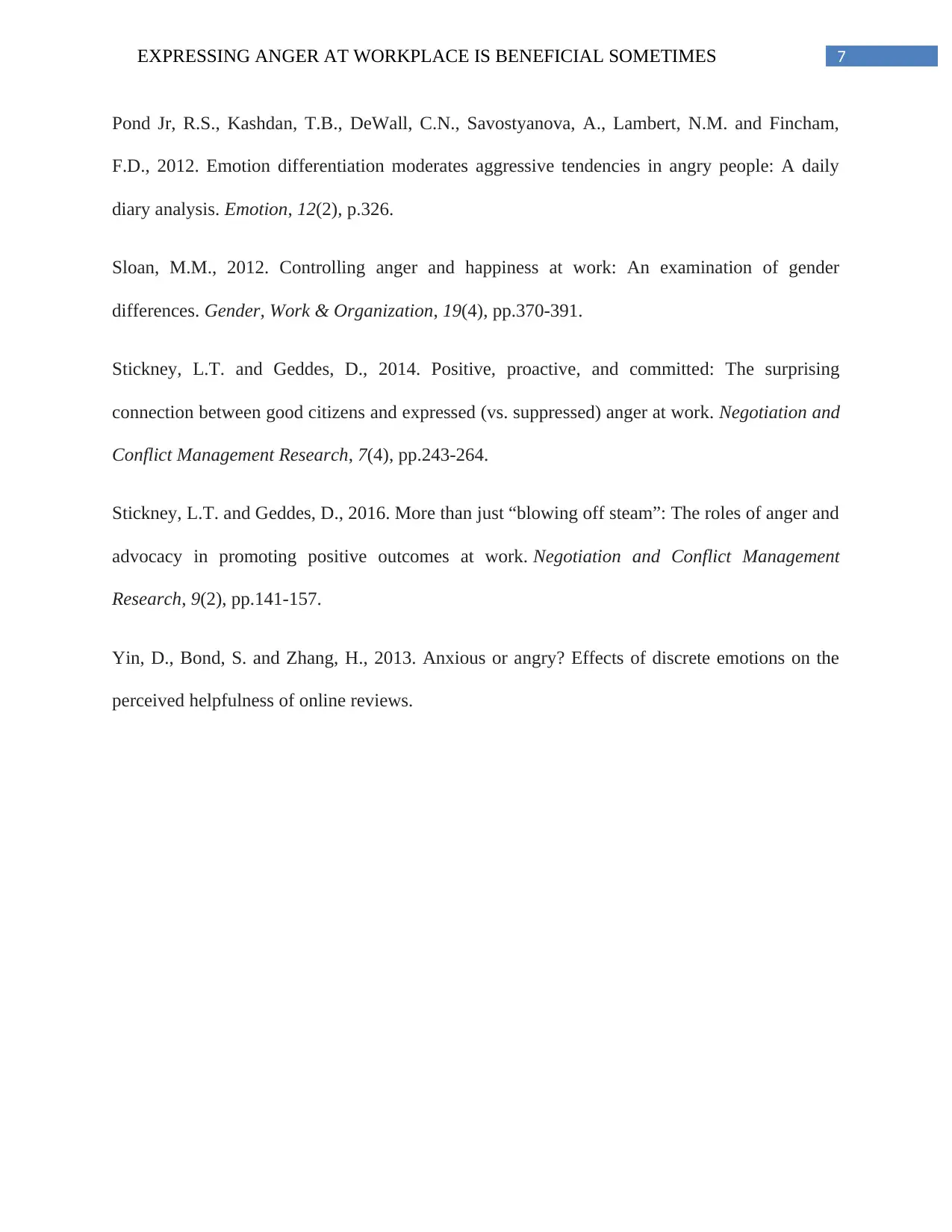
7EXPRESSING ANGER AT WORKPLACE IS BENEFICIAL SOMETIMES
Pond Jr, R.S., Kashdan, T.B., DeWall, C.N., Savostyanova, A., Lambert, N.M. and Fincham,
F.D., 2012. Emotion differentiation moderates aggressive tendencies in angry people: A daily
diary analysis. Emotion, 12(2), p.326.
Sloan, M.M., 2012. Controlling anger and happiness at work: An examination of gender
differences. Gender, Work & Organization, 19(4), pp.370-391.
Stickney, L.T. and Geddes, D., 2014. Positive, proactive, and committed: The surprising
connection between good citizens and expressed (vs. suppressed) anger at work. Negotiation and
Conflict Management Research, 7(4), pp.243-264.
Stickney, L.T. and Geddes, D., 2016. More than just “blowing off steam”: The roles of anger and
advocacy in promoting positive outcomes at work. Negotiation and Conflict Management
Research, 9(2), pp.141-157.
Yin, D., Bond, S. and Zhang, H., 2013. Anxious or angry? Effects of discrete emotions on the
perceived helpfulness of online reviews.
Pond Jr, R.S., Kashdan, T.B., DeWall, C.N., Savostyanova, A., Lambert, N.M. and Fincham,
F.D., 2012. Emotion differentiation moderates aggressive tendencies in angry people: A daily
diary analysis. Emotion, 12(2), p.326.
Sloan, M.M., 2012. Controlling anger and happiness at work: An examination of gender
differences. Gender, Work & Organization, 19(4), pp.370-391.
Stickney, L.T. and Geddes, D., 2014. Positive, proactive, and committed: The surprising
connection between good citizens and expressed (vs. suppressed) anger at work. Negotiation and
Conflict Management Research, 7(4), pp.243-264.
Stickney, L.T. and Geddes, D., 2016. More than just “blowing off steam”: The roles of anger and
advocacy in promoting positive outcomes at work. Negotiation and Conflict Management
Research, 9(2), pp.141-157.
Yin, D., Bond, S. and Zhang, H., 2013. Anxious or angry? Effects of discrete emotions on the
perceived helpfulness of online reviews.
1 out of 8
Your All-in-One AI-Powered Toolkit for Academic Success.
+13062052269
info@desklib.com
Available 24*7 on WhatsApp / Email
![[object Object]](/_next/static/media/star-bottom.7253800d.svg)
Unlock your academic potential
Copyright © 2020–2025 A2Z Services. All Rights Reserved. Developed and managed by ZUCOL.